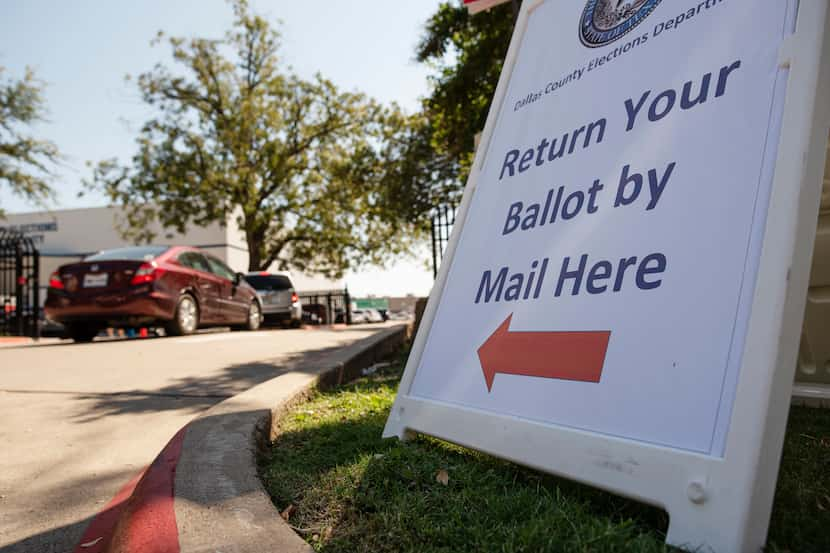AUSTIN — Multiple North Texas counties have seen a dramatic drop in mail-in ballots so far in early voting compared with the 2018 midterm elections, a Dallas Morning News review found.
In Texas, mail-in voting has long been more popular with Republican voters than with Democratic voters, experts say, but that has shifted dramatically in 2022. The chief reason appears to be the fear that mail-in voting is susceptible to voter fraud.
“Republicans have gotten the message that voting by mail might lead to voter fraud, which is the boogeyman for a lot of Republicans,” said University of Houston political scientist Brandon Rottinghaus. “Years of Republicans led by Donald Trump hammering the unproven allegations about voter fraud have spooked Republicans into voting in person instead of voting by mail.”
In Dallas County, there were 58% fewer mail-in ballots received through Tuesday than at the same point before the 2018 general election. About 19,000 fewer votes were submitted.
The same pattern is showing up across the surrounding counties — and the state. Through the first eight days of the early-voting period, Collin County has seen an 18% decrease. Tarrant County is about 43% off; Denton, about 14%; and Ellis, about 49%.
At a Robstown rally last month, Trump told the thousands in attendance to wait for Election Day to vote.
“What you do is you go out and vote on Election Day,” Trump said. “It’s harder to cheat when you do it that way.”
In the past, one reason GOP voters have heavily used mail voting is that they tend to be older, Rottinghaus said. Also, he added, Republican candidates encouraged it.
“People were drawn to the convenience of voting by mail,” he said.
But after Trump lost the 2020 election, which also drew a high-number of mail-in ballots because of COVID-19, the former president and other Republicans began to attack mail ballots and claimed — without evidence — that it contributed to voter fraud.
That claim was further advanced by the film 2,000 Mules which claims that people, or mules, dumped thousands of illegal votes for president in favor of Joe Biden at voting drop box sites. The film has been debunked by numerous fact-checkers and former Attorney General Bill Barr.
Last year, the Texas Legislature approved a controversial elections bill that added voter-identification requirements on mail-in voting. The changes resulted in confusion. Thousands of ballot applications were rejected by election officials.
That has led to shifting patterns, beginning in last March’s primaries, when about 47% of primary voters casting mail ballots were Democrats and 40% were Republicans, according to GOP elections analyst Derek Ryan. In the 2018 primaries, 42% of the ballots cast by mail were from Republicans and 31% were from Democrats, he said.
Collin, Tarrant, Denton and Ellis counties have been Republican-leaning counties in recent history. Tarrant has started to show some signs that it might be shifting — voting for Beto O’Rourke over U.S. Sen. Ted Cruz in 2018 and Biden over Trump in 2020. But Collin, Denton and Ellis have not shown a similar pattern.
Some experts say the decrease in mail-in voting could have a snowball effect on general election turnout — which is down considerably when compared with 2018. With fewer people voting by mail, more might show up at the polls on Election Day. That could lead to longer lines, which could lead to people deciding not to wait hours — especially if they have responsibilities, such as job duties or picking up kids from school.
“The voting process is a system,” Rottinghaus said. “If you push one lever, it’s going to alter outcomes in other ways.”


/cloudfront-us-east-1.images.arcpublishing.com/dmn/EZCUDS5AUPUUFV3U4IXFNBPODA.jpg)
/cloudfront-us-east-1.images.arcpublishing.com/dmn/C5T3J6VAXZHPNMZ5UYRXYWI6MQ.jpg)
/cloudfront-us-east-1.images.arcpublishing.com/dmn/DUVJADGS2NHJHEFELBH6WNSLXE.jpg)
/cloudfront-us-east-1.images.arcpublishing.com/dmn/YCCK6D63IM3ZX4LNXMDZBLMYVQ.jpg)
/cloudfront-us-east-1.images.arcpublishing.com/dmn/ZMOS73JZBIHODI7MGBVMUKVNWI.jpg)